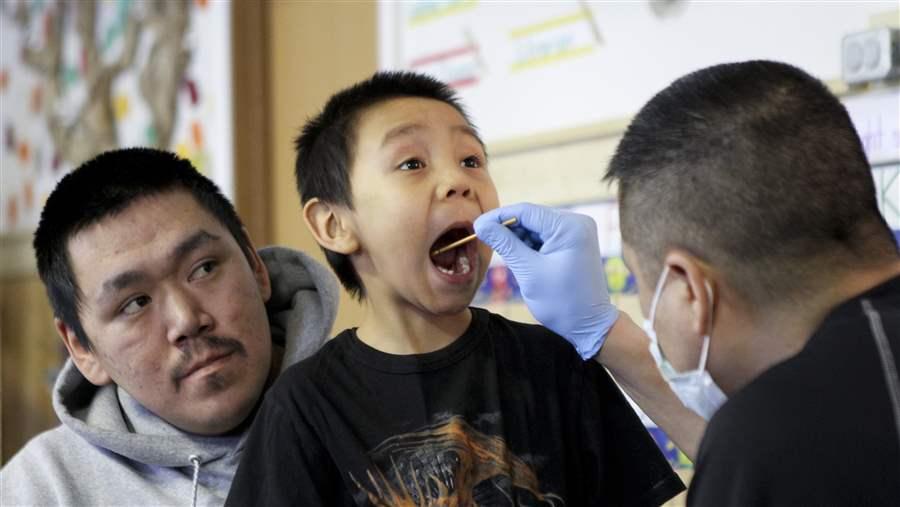5 Issues in Dental Health Care to Watch in 2016
 © The Pew Charitable Trusts
© The Pew Charitable TrustsFive major issues will drive or hinder success in helping Americans access dental care in 2016.
More than one-third of Americans face serious challenges in accessing dental care, including lack of insurance, prohibitive cost, too few providers, and mobility and transportation problems.1 As state policymakers around the country seek to better understand and take action to solve this crisis, five major issues will drive or hinder the success of those efforts:
-
Midlevel dental providers. Evidence is growing that expanding the dental team to include midlevel providers, often called dental therapists, helps dentists build their businesses while increasing access to high-quality, cost-effective care. A 2014 report from the Minnesota Board of Dentistry and Department of Health evaluated the impact of these providers and found that they expand access to care for vulnerable populations and improve the efficiency of clinics and dental offices. More states—including Kansas, Massachusetts, Michigan, New Mexico, Ohio, Oregon, Vermont, and Washington—are considering legislation, pilots, and other proposals to authorize such providers.
-
Education standards for dental therapy. The Commission on Dental Accreditation (CODA)—the accrediting body for academic dental programs—is working on implementing the dental therapy training standards that it finalized in August 2015. Once in place, these educational criteria would enable more students to enter the field of dental therapy. CODA has indicated that the first dental programs may be able to apply for accreditation as early as spring 2016.
-
School sealant programs. A strong body of research has documented the oral health disparities between low-income children and their more well-to-do peers.2 Barriers to care are fueled by the small number of dentists who accept Medicaid and the high number of people living in areas with dentist shortages.3 More than half of these children (nearly 18 million) received no dental care in 2014, not even a routine exam.4
School-based sealant programs that reach low-income children are effective in addressing these disparities in oral health care: Research shows that these programs reduce tooth decay by an average of 60 percent over five years.5 However, according to Pew’s 2015 report, 39 states and the District of Columbia lack sealant programs in most of their high-need schools. To inform policymakers' efforts to extend the reach of these services, Pew and the Children’s Dental Health Project are conducting major research projects to assess the barriers to program expansion as well as strategies for improving efficiency.
-
Working-age adults. Although the Affordable Care Act requires state Medicaid programs and private insurers to include dental care for children, the federal health law did little to expand dental coverage for adults. Erosion of private and public dental insurance, mounting costs of care, and a limited number of dentists who accept public coverage have fueled a drop in utilization by working-age adults (ages 19-64) across income levels and insurance status in recent years.6 In 2011, only 36 percent of working-age adults saw a dentist, and more than one-quarter had untreated tooth decay.7 Among those living in poverty, these figures were less than 20 percent and more than 40 percent, respectively.8 Meanwhile, the incidence of working-age adults seeking dental care in hospital emergency rooms has risen over the past decade.9
Millions of previously uninsured low-income adults gained coverage under the Affordable Care Act’s Medicaid expansions. But the newly insured in most states will receive a narrow package of dental benefits and struggle to find dentists who accept public insurance. Most states offer Medicaid enrollees either exclusively emergency dental care (such as tooth extractions to relieve pain) or limited care subject to restrictions such as caps on annual spending or numbers of procedures.10 In 2013, only about 34 percent of general dentists accepted Medicaid or other public insurance.11 Policymakers may face increasing pressure to offer remedies for these access barriers.
-
Oral health and aging. Americans are living longer and keeping more of their teeth in old age. As the elderly population increases, its oral health needs and ability to access care are garnering more attention. About 1 in 5 older Americans has untreated tooth decay, and more than 40 percent have periodontal diseases.12 However, an estimated 70 percent of seniors lack or have limited dental insurance, and fewer than half access dental care each year.13 Research shows that utilization declines with age, particularly because of transportation and mobility challenges.14 Policymakers in 2016 may be more inclined to consider coverage options for this population and to rethink how dental care is delivered to older Americans.
Learn more about these and other important trends and topics by signing up for the latest dental news and research from Pew.
Jane Koppelman is research director for children’s dental policy at The Pew Charitable Trusts, and Andrew Peters oversees state campaigns on dental sealant policies at Pew.
Endnotes
- National Association of Dental Plans, “Who Has Dental Benefits,” http://www.nadp.org/Dental_Benefits_Basics/Dental_BB_1.aspx#_ftn1; Health Resources and Services Administration, “Shortage Designation: Health Professional Shortage Areas & Medically Underserved Areas/Populations,” last modified July 1, 2015, http://www.hrsa.gov/shortage; and General Accountability Office, “Dental Services: Information on Coverage, Payments, and Fee Variation,” GAO-13-754 (2014), http://www.gao.gov/assets/660/657454.pdf.
- Bruce A. Dye et al., ‘Trends in Oral Health Status: United States, 1988–1994 and 1999–2004,” National Center for Health Statistics, Vital and Health Statistics 11, no. 248 (2007): 23, Table 10, http://www.cdc.gov/nchs/data/series/sr_11/sr11_248.pdf.
- American Dental Association, “Characteristics of Private Dental Practices: Selected 2013 Results From the Survey of Dental Practice” (February 2015), http://www.ada.org/~/media/ADA/Science and Research/HPI/Files/HPIData_SDPC_2013.ashx; and U.S. Department of Health and Human Services, Health Resources and Services Administration, “Find Shortage Areas: HPSA by State and County,” accessed April 8, 2014, http://hpsafind.hrsa.gov.
- This figure includes children through age 20 who are eligible for the Early and Periodic Screening, Diagnostic, and Treatment (EPSDT) benefit. U.S. Department of Health and Human Services and Centers for Medicare & Medicaid Services, Annual EPSDT participation report (Form CMS-416 (national) fiscal year 2014), http://www.medicaid.gov/Medicaid-CHIP-Program-Information/By-Topics/Benefits/Early-and-Periodic-Screening-Diagnostic-and-Treatment.html.
- Benedict I. Truman et al., “Reviews of Evidence on Interventions to Prevent Dental Caries, Oral, and Pharyngeal Cancers, and Sports- Related Craniofacial Injuries,” American Journal of Preventive Medicine 23, 1 Suppl. (2002): 21–54, http://www.ncbi.nlm.nih.gov/pubmed/12091093.
- K. Nasseh and M. Vujicic, “Dental Care Utilization Continues to Decline Among Working-Age Adults, Increases Among the Elderly, Stable Among Children,” Health Policy Institute Research Brief, American Dental Association (October 2013), http://www.ada.org/~/media/ADA/Science and Research/HPI/Files/HPIBrief_1013_2.ashx; K. Nasseh and M. Vujicic, “Dental Care Utilization Rate Continues to Increase Among Children, Holds Steady Among Working Age Adults and the Elderly,” Health Policy Institute Research Brief, American Dental Association (October 2015), http://www.ada.org/~/media/ADA/Science and Research/HPI/Files/HPIBrief_1015_1.ashx; and American Dental Association, “Characteristics of Private Dental Practices: Selected 2013 Results From the Survey of Dental Practice (2013), http://www.ada.org/~/media/ADA/Science and Research/HPI/Files/HPIData_SDPC_2013.ashx.
- Nasseh and Vujicic, “Dental Care Utilization Continues to Decline Among Working-Age Adults”; and B.A. Dye et al., “Dental Caries and Tooth Loss in Adults in the United States, 2011–2012,” National Center for Health Statistics, NCHS Data Brief no. 197 (2015), http://www.cdc.gov/nchs/data/databriefs/db197.htm.
- Nasseh and Vujicic, “Dental Care Utilization Continues to Decline Among Working-Age Adults; and B.A. Dye, X. Li, and E.D. Beltran-Aguilar, “Selected Oral Health Indicators in the United States, 2005–2008,” National Center for Health Statistics, NCHS Data Brief no. 96 (2012), http://www.cdc.gov/nchs/data/databriefs/db96.htm.
- T. Wall and M. Vujicic, “Emergency Department Use for Dental Conditions Continues to Increase,” Health Policy Institute Research Brief, American Dental Association (April 2015), http://www.ada.org/~/media/ADA/Science and Research/HPI/Files/HPIBrief_0415_2.ashx.
- Center for Health Care Strategies, “Medicaid Adult Dental Benefits: An Overview” (2015), http://www.chcs.org/media/Adult-Oral-Health-Fact-Sheet_101915.pdf.
- American Dental Association, “Characteristics of Private Dental Practices: Selected 2013 Results From the Survey of Dental Practice” (2013), http://www.ada.org/~/media/ADA/Science and Research/HPI/Files/HPIData_SDPC_2013.ashx.
- Dye et al., “Dental Caries and Tooth Loss in Adults in the United States, 2011–2012”; and C.M. Vargas, E.A. Kramarow, and J.A. Yellowitz, The Oral Health of Older Americans, National Center for Health Statistics, Aging Trends no. 3. (2001), http://www.cdc.gov/nchs/data/ahcd/agingtrends/03oral.pdf.
- Oral Health America, “A State of Decay: Are Older Americans Coming of Age Without Oral Healthcare?” (2013), http://www.dentistryiq.com/content/dam/diq/online-articles/documents/2013/10/OHA_State_of_Decay_2013.PDF; and R.J. Manski and E. Brown, “Dental Use, Expenses, Private Dental Coverage, and Changes, 1996 and 2004,” MEPS Chartbook no. 17 (2007), http://meps.ahrq.gov/data_files/publications/cb17/cb17.pdf.
- Manski and Brown, “Dental Use.”







